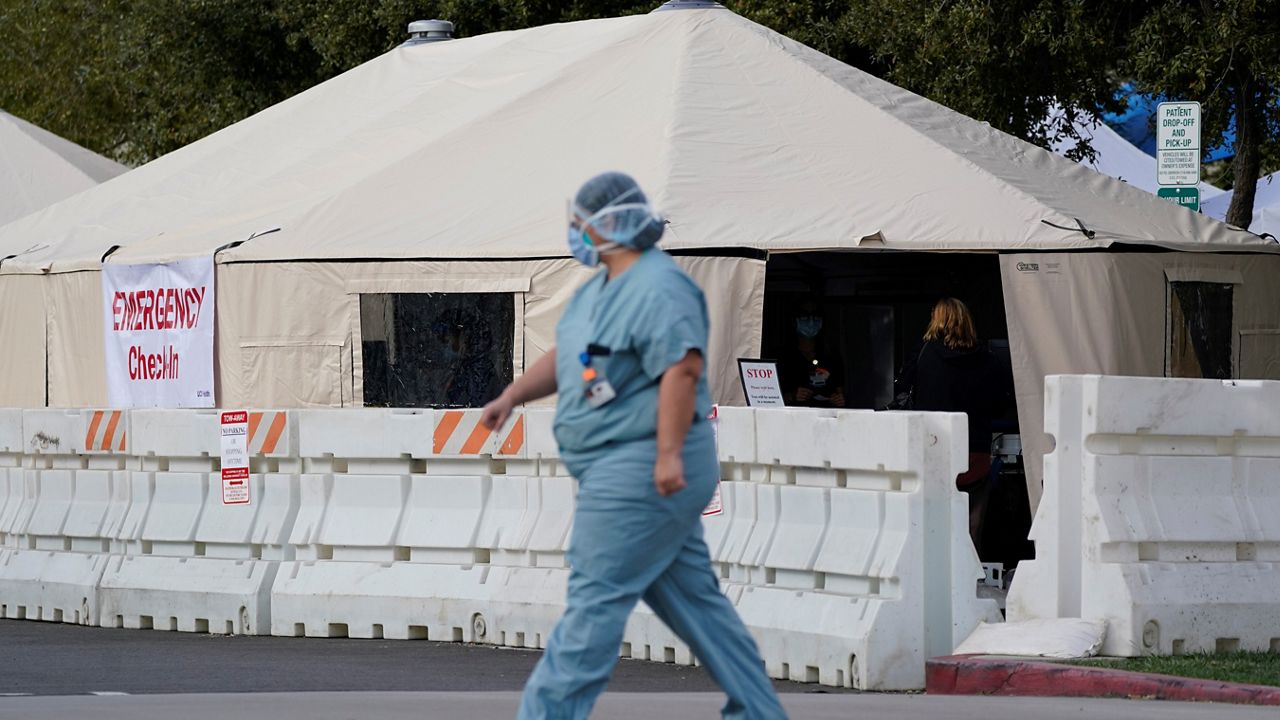SANTA ANA, Calif. (CNS) — Orange County's COVID-19 rates continued trending down while hospitalizations tied to the virus remained level, according to data released Tuesday by the Orange County Health Care Agency.
What You Need To Know
- Dr. Clayton Chau, the county's chief health officer and director of the OCHCA, said that conditions have "improved dramatically"
- He said 10 children are hospitalized with COVID-19 symptoms, but none are in ICU
- The county also reported 257 new positive COVID tests and eight additional deaths, raising the cumulative totals to 538,851 and 6,617 respectively
- The county had 28.1% of its ICU beds available and 64.1% of its ventilators as of Tuesday
The number of COVID-positive patients in Orange County hospitals ticked up from 230 on Monday to 233, while the number of those patients in intensive care dropped from 40 to 35.
The case rate per 100,000 people decreased from 12.6 Monday to 11. The testing positivity rate dropped from 3.8% to 3.7%, but ticked up from 3.2% to 3.3% in the health equity quartile, which measures underserved communities hardest hit by the pandemic.
Dr. Clayton Chau, the county's chief health officer and director of the OCHCA, told reporters Tuesday that conditions have "improved dramatically."
He said 10 children are hospitalized with COVID-19 symptoms, but none are in ICU.
The county also reported 257 new positive COVID tests and eight additional deaths, raising the cumulative totals to 538,851 and 6,617 respectively.
The county had 28.1% of its ICU beds available and 64.1% of its ventilators as of Tuesday. Local health officials become concerned when the level of ICU beds falls below 20%.
Of those hospitalized, 84% are unvaccinated and 86% in an intensive care unit are not inoculated.
Of the deaths logged Tuesday, all occurred in February, raising February's death toll to 144. January's death toll stands at 487, and December's death toll stands at 108.
November's death toll stands at 112, October's at 136, September's at 200 and August's at 186.
In contrast, the death toll before the delta variant fueled a late-summer surge was 31 in July, 20 in June, 26 in May, 47 in April, 202 in March and 620 for February.
January 2021 remains the deadliest month of the pandemic, with a death toll of 1,600, ahead of December 2020, the next-deadliest, with 986 people lost to the virus.
The case rate per 100,000 people decreased from 14.5 on Feb. 12 to 8.7 on Saturday for those fully vaccinated with a booster shot; from 17.4 to 10 for those fully vaccinated with no booster; and 30.1 to 17.9 for those not fully vaccinated.
With mask requirements being relaxed in businesses and next week in public schools, Dr. José Mayorga, executive director of the UC Irvine Family Health Center, cautioned against putting the face coverings away for good.
"If you're not fully vaccinated you should be wearing a mask," Mayorga told City News Service.
He noted the high level of fatalities during the omicron surge compared with previous surges.
"I think there's an extreme misconception that this is a milder variant, but if you look at simply the number of deaths compared to prior surges this is a significant higher number of deaths, but you have to correlate that with the higher number of cases and when you have more cases you have more deaths," Mayorga said. "More people got it so subsequently more people succumbed to it."
Mayorga also pointed out there are some people still not eligible for a vaccine, such as children younger than 5 and some who are immunocompromised.
The physician said it was "disheartening" that "we're starting to normalize illness and death that is absolutely preventable."
He encourages parents to ask school administrators what they are doing to prepare before masks become voluntary for students on March 11. Mayorga encouraged school officials to open windows and doors to increase ventilation. "Press the schools ... what is your mitigation plan for any potential outbreaks and how are you keeping us safe in the classroom?"
Mayorga is also concerned about long COVID symptoms for children and what impact they will have in the long run.
"Our long-COVID clinic here at UCI has seen younger aged folks coming in and seen in a clinic due to this omicron surge versus prior ones, which is, again, very, very concerning because there's no treatment for it and people should be genuinely concerned," Mayorga said.
He's also concerned with the low level of vaccine uptake among children in the county.
"I think we need to do a better job of getting parents comfortable with getting this vaccine on board because we do know that having your child vaccinated is going to reduce risk of severe illness or hospitalization," Mayorga said. "We need to do a better job of helping parents make a decision."
Chau agreed.
"I would like to encourage our parents out there making decisions to really have a conversation with your pediatrician," Chau said. "Learn more about the vaccines and children."
More children were sickened by COVID-19 during the recent surge than in previous ones, Chau said. In the most recently eligible age group for vaccines, about 32% of 5 to 11-year-olds are vaccinated, Chau said.
For seniors, "close to 100%" have received at least one dose of vaccine, Chau said, adding that "93% are fully vaccinated."
